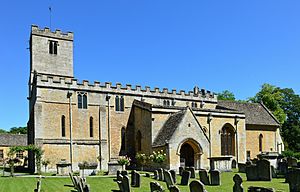Church of St Mary, Bibury facts for kids
Quick facts for kids Church of St Mary |
|
|---|---|
 |
|
| Lua error in Module:Location_map at line 420: attempt to index field 'wikibase' (a nil value). | |
| Denomination | Church of England |
| Architecture | |
| Heritage designation | Grade I listed building |
| Designated | 26 January 1961 |
| Administration | |
| Parish | Bibury |
| Diocese | Gloucester |
| Province | Canterbury |
The Church of St Mary is a very old church located in Bibury, a beautiful village in Gloucestershire, England. It was built way back in the 11th century, which means it's over 900 years old! This church is so important that it's officially recognized as a Grade I listed building. This means it's a special historic building that needs to be protected.
Contents
A Look Back in Time
How Old Is the Church?
The very first church in Bibury was built a long, long time ago, around the year 899. The current stone church, which you can see today, was mostly built by the Anglo-Saxons in the middle to late 1000s. Over the centuries, more parts were added and changed.
Changes Over the Years
For a long time, the church belonged to a monastery called Osney Abbey. This changed during a big time in English history when many monasteries were closed down.
In 1863, the church had a major makeover. This was called a "Victorian restoration" because it happened during the Victorian era. A famous architect named George Gilbert Scott helped with this work. More changes and repairs happened later in the 1800s. In 1920, the church's organ was moved to a different part of the building.
The Church of St Mary is part of the Church of England. It serves the local community in Bibury as part of the Diocese of Gloucester.
Inside and Out
What the Church Is Made Of
The Church of St Mary is built from limestone, a type of stone often found in the Cotswolds. Its roof is made of stone slates, which are flat pieces of stone.
Parts of the Church
The church has several main parts:
- The nave is the main area where people sit.
- It has aisles on the north and south sides, which are walkways along the sides of the nave.
- A clerestory is a row of windows high up on the walls, letting in light.
- The chancel is the part of the church near the altar, usually where the choir sits.
- There's also a south porch, which is an entrance area.
The Tower and Its Bells
The church has a tower that rises from its north-west corner. This tower is supported by strong walls called buttresses. Inside the tower is a belfry from the 1400s, which is where the church bells are kept.
Ancient Stones and Art
You can find a very old Saxon stone grave slab built into the north wall of the church. Four other similar Saxon slabs from Bibury were given to the British Museum in London.
The north doorway of the church was built around 1180, making it very old too!
Special Features Inside
Inside the church, there's a font from the 1200s. A font is a basin used for baptisms. This one is unusual because it's square, and its sides are carved with arch shapes.
The church also has beautiful stained glass windows. Some of the oldest glass dates back to the 1200s. More recent stained glass was created by artists like Thomas Willement and William Wailes. A special piece of glass by Karl Parsons, installed in 1927, was even featured on a Christmas stamp in 1992!

